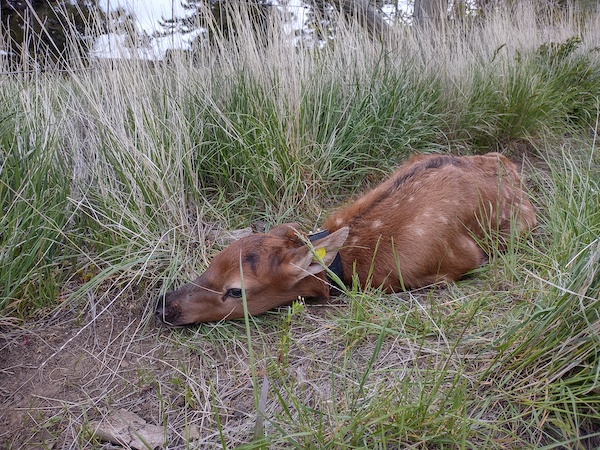
2nd Blue Mountains Cougar Tag Proposal Approved
Hunters will be able to take a second cougar in Southeast Washington’s Blue Mountains this season after Fish and Wildlife Commissioners narrowly approved WDFW’s proposal to try and reduce mountain lion predation on a hard-bitten elk herd.

The vote was 5-4, with Commissioner John Lehmkuhl of Wenatchee casting the key vote.
“I think it could be successful to give the [elk] population a respite,” he said, and added that he believed the cougar population is resilient, and he also called for strong monitoring around the effort.
Commissioner Kim Thorburn of Spokane made the motion to increase tags and she was seconded by Jim Anderson of Buckley. Also voting in favor were Vice Chair Molly Linville of Douglas County and Commissioner Don McIsaac of rural Clark County.
While hunters will be able to bag a second cougar in game management units in the eastern half of the Blues with purchase of a second tag, the overall state harvest guideline will remain the same, 18 to 22 animals. Hunters are required to report their kills.
Lehmkuhl’s support for the proposal surprised several fellow commissioners who he’d joined earlier in the meeting in voting to essentially put spring bear season-setting scheduling on pause until the panel decides on a policy around that hunt.
“Wow,” said Chair Barbara Baker of Olympia after he’d finished speaking, adding that she was about to say he had otherwise been making her points for her.
Before announcing how he was inclined to vote, Lehmkuhl had noted the elk population was at a low point, he saw issues around the region’s carrying capacity, it wasn’t clear to him whether cougar predation was additive or compensatory, and while WDFW staffers had done a pretty thorough assessment, the agency’s proposal seemed something of a try-it-and-see-what-happens deal.
Baker called for another year’s worth of calf mortality data – of 2021’s 125 captured-and-collared neonates, just nine are known to have survived through last March, with 77 lost due to predation and 55 by cougars – and wanted a deeper look at habitat issues in the region.
She and Commissioners Lorna Smith of Port Townsend, Melanie Rowland of Twisp and Tim Ragen of Anacortes pointed to drought that may affect forage that may in turn affect cow elk health and thus neonate success.
But Commissioner Jim Anderson called that “a red herring more than a substantive issue.”
He pointed to WDFW’s assessment last year that the elk herd is at risk and felt that the commission was in “good hands” with the work agency staffers have done studying the problem.
For Game Division manager Anis Aoude, “the issue is not habitat, it’s predation.”
He said carrying capacity is sufficient in the Blue Mountains for the herd objective of 5,500 elk – the latest survey showed 3,600 – but that predation is keeping the animals from rebuilding from the wapiti-killing winter of 2016-17.
Along with the calf mortality study, aerial surveys earlier this year found just 17 calves per 100 cows, well below levels needed to stabilize the herd – let alone rebuild it.
Year two of calf captures began in May but biologists weren’t able to collar as many as 2021 due to not finding enough in the Tucannon Game Management Unit and not wanting to stress the animals there.
Aoude said the idea around the additional tag is to use hunters to try and help the situation, as WDFW’s only other legal option is trapping and removing cougars, a “time-intensive” proposition that might also “not pencil out,” comparatively, he said. A 1990s initiative bars even WDFW from using hounds in this particular scenario.
“I don’t think it’s aggressive enough,” said Anderson about the second tag – a common point hunters have made – “but sitting back until the herd spirals and crashes due to low recruitment isn’t wise or common sense.”
He acknowledged that the issue is complex, but also that cougar predation is the problem.
“Give these elk a chance, they’ll rebound,” Anderson said.
He also stated the commission needed to consider the herd’s importance to the local community and in relation to WDFW’s land acquisitions in the area and general goals of buying more ground, and how difficult that might become if the issue isn’t addressed, essentially a “good neighbor perspective.”
But taking up where former commissioner Fred Koontz left off, Smith pointed to input from researchers outside WDFW who disagreed with the agency’s findings on Blues elk issues. And she again questioned whether the herd objective was realistic, and if it would really be in crisis if the number was just set lower.
As Eric Barker at the Lewiston Tribune pointed out, Anderson responded with, “Population objective is not the issue. It’s the recruitment, or the failure of the recruitment. We are seeing a continued decline in that herd that is driven by recruitment. So you can set the population number wherever you want, but as long as you have a recruitment problem, you’ve got a problem.”
And harkening back to earlier in the day and the shelving of the spring bear hunt, McIsaac said it seemed to him like “there’s a very high threshold for not wanting any more carnivore hunting, cougar hunting, and that’s a driving reason among some.”
Ragen said not enough is known about tribal hunting, words that might have been better considered.
And Rowland once again raised her claim that this is just all about needing more elk on the landscape so hunters could kill more of them, and said more elk weren’t needed because of agricultural damage issues caused by the animals.
Crop depredations in fact are occurring in areas of the Blues that are not experiencing the extreme calf mortality seen in the eastern half of the range.
But the longer Rowland railed about killing cougars to kill more elk and “a very disturbing underlying context for this whole proposal,” the more confusing she became.
“I don’t understand any of that,” stated Anderson when she wrapped up.
And then the commission voted in favor of Doing Something about a clear predation problem instead of sitting on their hands.
Thank you.
Overall, it was a mixed day for the citizen panel as it relates to hunting in Washington, but it could have been so much worse had the cougar vote gone the other way, what perhaps would have been a death knell for predator hunting as a management tool and tradition.
“The Commission decision to expand cougar opportunity reaffirms the critical role that hunting can play in responsible, scientific wildlife management,” stated Dan Wilson, secretary of the Washington chapter of Backcountry Hunters and Anglers. “Unfortunately, the decision to further deny a spring bear season undermines not only the North American Model, but the Commission’s own rules and procedures. It also shows a continued behavior by some commissioners to selectively apply their mandate, acknowledge tribal input and adhere to existing policies when it suits them. Until this commission can remove preservationist and precautionary-based decision-making and actively engage in management, our wildlife will suffer, responsible opportunity will be denied, and co-manager input will be shamefully marginalized.”

